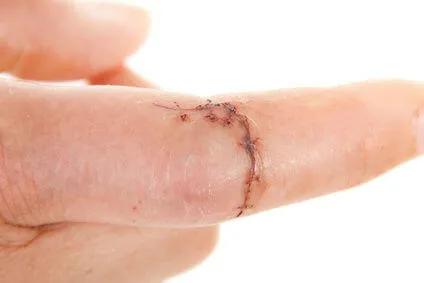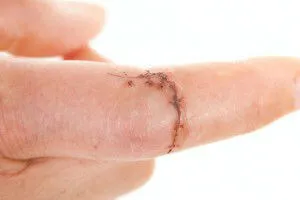
- Share on Facebook54
- Share on Pinterest
- Share on Twitter
It’s rare enough to contract necrotizing fasciitis, otherwise known as “flesh-eating bacteria.” But a 44-year-old man recently came down with an extremely rare case of double necrotizing fasciitis when the original infection spread to a second site.
The individual’s original complaint was of severe back pain and fever. He was prescribed a first round of painkillers that did nothing to soothe his pain. After another round of stronger pain medication proved ineffective and the fever persisted, he once again went to the doctor who discovered his right buttock was inflamed.
A round of powerful antibiotics was administered to no avail and within six hours his left arm had also begun to turn red and swell. He was quickly transferred to the emergency room where doctors began to fear a diagnosis of necrotizing fasciitis.
After performing a CT scan, the doctors found that the connective tissue, or fascia, in the man’s left arm and right buttock had begun to thicken with gas bubbles present. This was when doctors knew they had not only a serious case on their hands, but an extremely rare case.
“It’s difficult to diagnose necrotizing fasciitis, because in the early stages, the signs and symptoms tend to be very wide, very general, very easily confused with minor diseases and minor conditions,” said Dr. Ilaria Tocco Tussardi of the Institute of Plastic Surgery at University Hospital of Padova in Italy.
In fact, contracting the infection is quite rare in the first place with only four in every one million people diagnosed each year. Yet 30 percent of cases often prove lethal due to a delayed diagnosis.
This serious infection can be caused by a number of bacteria, but is most commonly the case of group A Streptococcus bacteria, the same bacteria responsible for strep throat, entering the body via a wound or scratch. In this case, the man had no recollection of any such wound at either site.
Doctors speculate that the bacteria managed to infect the bloodstream and travel from one site to the other. He was also a diabetic, meaning his immune system was compromised, a risk factor for developing the life-threatening condition.
By the time doctors were able to reach a diagnosis, a majority of the damage had been done. Surgeries were performed to remove as much infected tissue as possible and his entire arm was amputated, yet the infection had greatly weakened his heart, circulatory and respiratory systems and he slipped into a coma. He was moved to a residential facility for permanent coma patients.
 Contracting two simultaneous cases of necrotizing fasciitis is extremely rare. Researches have only documented 33 cases in the past 50 years. Most healthy individuals who practice good hygiene won’t contract the infection.
Contracting two simultaneous cases of necrotizing fasciitis is extremely rare. Researches have only documented 33 cases in the past 50 years. Most healthy individuals who practice good hygiene won’t contract the infection.
Those with compromised immune systems or who don’t properly treat a wound are more at risk. If you do experience a cut or wound, be sure to properly clean the area and keep it covered. Avoid swimming pools or other bodies of water until the wound has healed.
Signs that you may have contracted a more serious infection include pain, redness or swelling at the site accompanied by fever, chills or vomiting. See a medical professional immediately if you experience any of these signs.
-The Alternative Daily
Sources:
http://www.cbsnews.com/8301-204_162-57607745/rare-double-infection-of-flesh-eating-bacteria-puts-man-in-coma/
http://www.cdc.gov/features/necrotizingfasciitis/
- Share on Facebook54
- Share on Pinterest
- Share on Twitter

